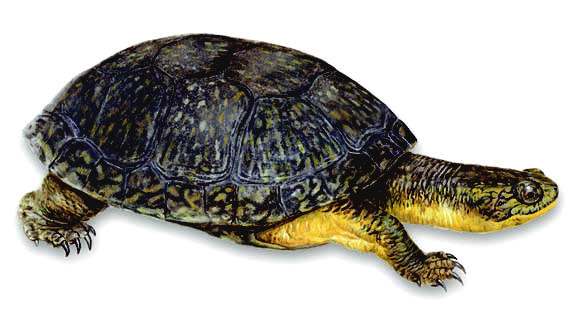Blanding's Turtles Conservation
Blanding's Turtles are a New York State-listed Threatened Species found in many parts of the State, including Dutchess County. These animals typically grow to about 10" in length, but can be much smaller as hatchlings. They are distinguished by a yellow neck and chin, and a black top shell with yellow flecks that may fade with age. The bottom of the shell is yellow with black blotches. Though turtles reach maturity at 16 years, some can live up to 60 years. Blanding's Turtles often hide in tall vegetation and exposed rocky soils, live and hibernate in freshwater wetlands, and will use multiple wetlands and surrounding uplands during the course of the year for nesting and migration. They emerge from hibernation in the spring (April 15th). Turtles then migrate into other wetlands for food, and eventually into gravelly soils to nest during mid-May to late June, often nesting at night. They may travel long distances, up to a mile or more in a season.
 Anyone living within the range of Blanding's turtles in Dutchess County or who is concerned about all species of turtles, can take steps in their everyday life to help protect them. Many of these steps will also protect wildlife in general, including other species of reptiles and amphibians, small mammals, and birds, which face many of the same threats as the Blanding's Turtle.
Anyone living within the range of Blanding's turtles in Dutchess County or who is concerned about all species of turtles, can take steps in their everyday life to help protect them. Many of these steps will also protect wildlife in general, including other species of reptiles and amphibians, small mammals, and birds, which face many of the same threats as the Blanding's Turtle.
- Turtles are most active during the season from April to October, so it's important to check for turtles underneath a parked car before driving.
- Drive carefully to avoid accidents with turtles and other wildlife. If you see a "rock" in the road, slow down-it may be a turtle! When you encounter a turtle on the road, stop and move it off the road in the direction it was heading. Do not take it home or move it more than 300 feet. Always be careful not to endanger yourself in traffic.
- Watch for turtles when mowing or using motorized equipment, especially during the June nesting season when Blanding's Turtles may travel long distances overland.
- Eliminate pitfall hazards such as abandoned swimming pools, open excavations, unscreened window wells, ditches, and unscreened storm drains which can trap turtles and other small animals. In-ground swimming pools that are in use should have fencing with spaces less than 2.5 cm (1 in) apart to keep small turtles and other animals out.
- Alter vertical barriers such as stone walls, stockade fences, or chain-link fences so that turtles can pass under them. Spaces should be no less than 4 inches high and no more than 82 feet apart to allow turtles and other wildlife free movement across the landscape.
- Create no new lawn areas. Consider natural landscaping, such as shrub thickets, sparse wildflower/grass gardens, and brush piles to replace parts of your current lawn.
- If you have a dirt pile or other areas of loose, exposed soil, refrain from digging in it between May 26 and September 30. If you have a garden, consider fencing it. Otherwise, you may accidentally dig up turtle eggs!
- Keep cats indoors during the active season (April to October) or supervise them when they are outdoors. Supervise dogs when they are outdoors. Keeping cats indoors and supervising dogs outdoors not only contributes to the safety of your pet and Blanding’s Turtles, but also protects many other wildlife species; see https://abcbirds.org/threat/cats-and-other-invasives/ for more information on controlling domestic animals engagement with wildlife.
- Refrain from using pesticides, herbicides, and other toxic substances on your lawn or garden; instead use the many natural alternatives now available.
- Dump no toxic substances, such as used motor oil, antifreeze, or cleaning products outside. These are toxic to turtles and other wildlife, and could potentially contaminate your drinking water. Dispose of them properly, according to the manufacturer’s instructions.
- Keep garbage lidded and compost piles contained and feed pets indoors to discourage predators of turtle eggs and hatchlings, such as raccoons, skunks, and opossums.
- Do not collect turtles. Protect turtles from collectors and help to educate would-be turtle collectors. The New York Environmental Conservation Law imposes a fine of up to $1,000 per occurrence for collecting without a permit, harassing, or killing a Blanding's Turtle.
- Protect wetlands, streams, and upland areas from drainage, channelization, filling, dumping, pollution, and other damage. According to state law, it is illegal to modify any wetland known to be used by Blanding's turtles.
- Encourage your Planning Board and Conservation Advisory Council to incorporate Blanding's Turtle habitat protection measures into their planning and decision-making.
- If you find a Blanding's Turtle, contact the New York State Department of Environmental Protection Region 3 in New Paltz (845.256.3091). Provide information on the date, location and any tags, and take a photo of the turtle if possible. If the turtle is in an area of high risk, move it a short distance out of harm's way but do not take it away with you.


